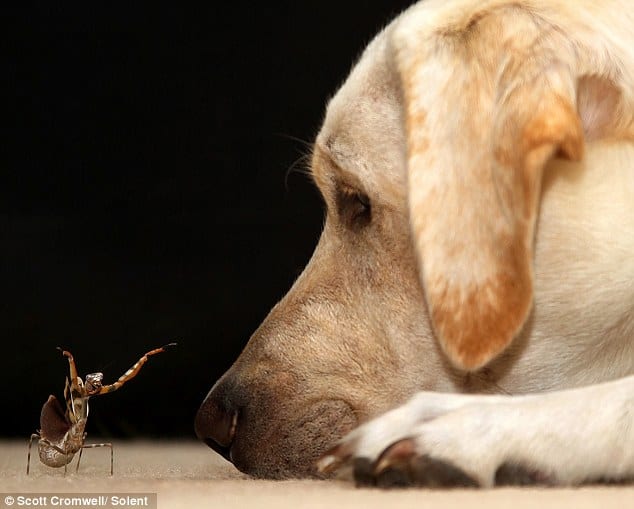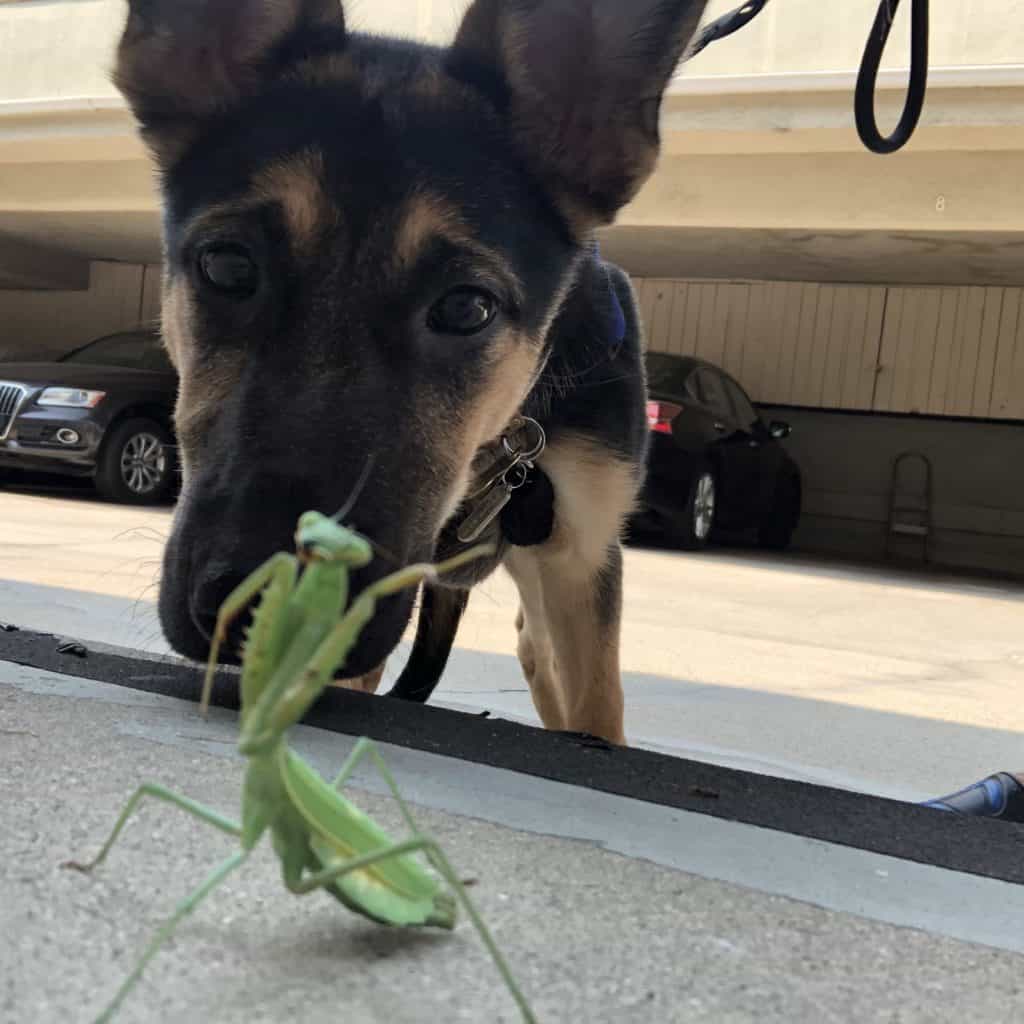Picture this: your furry friend, with a nose for adventure and a taste for the unusual, comes face to face with a fascinating creature known as the praying mantis. With its uncanny appearance and captivating movements, you might find yourself wondering, “Are praying mantis dangerous to dogs?” Fear not, pet owners! In this enlightening journey, we’ll explore the curious dynamics between dogs and praying mantises, including the alluring mystery of a dog munching on a mantis. Get ready to dig into the truth behind the questions you’ve been buzzing about: Can a praying mantis hurt a dog? Is it poisonous? And what on earth happens after a dog ate praying mantis?

Can a praying mantis hurt a dog?
When it comes to the safety of our furry friends, concerns about potential threats are only natural. If you have a dog and live in an area where praying mantises are common, or you have one in the terrarium you may be asking yourself: Can a praying mantis actually pose a threat to my beloved pup? In the case of praying mantises, however, dog owners can take a sigh of relief, you shuld be more concerned about mantises eating beneficial insects in your yard.
Generally speaking, a praying mantis is unlikely to pose any significant harm to dogs. These captivating insects may sport sharp front legs and an imposing appearance, but their primary focus is on hunting smaller prey like insects. While a praying mantis might engage in defensive behavior if provoked, their small size and limited means of defense make them an unlikely threat to our canine companions. So, rest assured that the chances of a praying mantis inflicting harm on your dog are quite slim. However, as with any animal encounter, it’s important to remain vigilant and observe your dog’s behavior to ensure their safety during their curious escapades.
How can praying mantises and dogs meet each other?
In the vast tapestry of life’s encounters, dogs and praying mantises may find themselves unexpectedly crossing paths. It could happen during a leisurely walk in the park, where Fido’s curious nose leads him to the fascinating world of a praying mantis. As he sniffs around the grass and explores his surroundings, he might stumble upon this mysterious insect. Similarly, within the cozy confines of our homes, the unexpected escape of a mantis from its terrarium can lead to a surprising encounter with our inquisitive canine companions.
Praying Mantis tries to fight a Puppy.
by u/atroxima in Grapplerbaki
Oh No! My Dog Ate a Praying Mantis!
It’s the moment of panic every pet owner dreads – you catch your mischievous pup mid-munch, with a praying mantis in their mouth. Your heart skips a beat as you wonder, “What happens now?” While it may sound like an unusual snack choice, rest assured that in most cases, if your dog ingests a praying mantis, there’s no need to hit the panic button just yet. The small size and relatively harmless nature of a praying mantis mean that, for the most part, your furry friend will be just fine. Their digestive system is equipped to handle a variety of unexpected food items, including the occasional insect indulgence.
However, as a responsible pet owner, it’s always a good idea to keep a close eye on your dog for any signs of discomfort or unusual behavior. If you notice any concerning symptoms, such as vomiting or diarrhea, it’s best to consult your veterinarian for further guidance. Remember, even in the quirkiest of situations, the health and well-being of your beloved canine companion are of the utmost importance. However, just because these insects generally do not pose a threat to our furry companions, it does not mean that our dogs can eat praying mantises. It is best to avoid situations where our little pups indulge in unexpected snacks.
Unraveling the Mystery: Are Praying Mantises Poisonous to Dogs?
When it comes to the topic of praying mantises and their potential toxicity to dogs, a sense of curiosity lingers in the air. While praying mantises possess certain adaptations for hunting, such as sharp forelegs, their primary prey consists of smaller insects rather than larger animals like dogs. In general, praying mantises are not known to be poisonous to dogs. These fascinating creatures lack the venomous capabilities found in some other insects, which means that even if your curious canine were to have a close encounter with a mantis, the risk of toxicity is minimal.
However, it’s important to note that individual sensitivities and allergies can vary among dogs, so it’s always wise to keep a watchful eye on your pet’s behavior after any unusual interactions. As with any potential hazards, prevention and vigilance remain key to ensuring the well-being of our beloved furry friends.

Keeping Dogs and Praying Mantises in Harmony
While the chances of praying mantises causing harm to dogs are minimal, it’s always a good idea to take preventive measures and follow some safety tips to ensure a harmonious coexistence between our canine companions and these intriguing insects. Here are some helpful guidelines to keep in mind:
- Supervise Outdoor Explorations: When walking your dog in areas known for praying mantis activity, it’s a good practice to keep a watchful eye on their surroundings. By staying alert, you can guide your dog away from any potential mantis encounters and prevent them from becoming too curious.
- Avoid Ingestion: Although praying mantises are generally safe for dogs to be around, it’s best to discourage your pup from eating them. To prevent any accidental ingestion, redirect their attention with toys or treats and reinforce positive behaviors.
- Maintain a Secure Terrarium: If you keep a pet mantis in a terrarium at home, ensuring its secure enclosure is crucial. Regularly check for any openings or gaps that could allow the mantis to escape and potentially trigger a surprise encounter with your dog.
- Educate Family Members and Visitors: It’s essential to educate everyone in your household, as well as visitors, about the presence of a pet mantis. Encourage them to be mindful of their interactions with the mantis and to notify you immediately if any accidental escape occurs.
- Consult Your Veterinarian: If your dog exhibits any unusual symptoms or behaviors after an encounter with a praying mantis, it’s always advisable to consult your veterinarian. They can provide professional guidance and address any concerns regarding your pet’s health.
Are praying mantis dangerous to cats?
Okay, we have been talking about dogs, but what about cats? Praying mantises are generally not considered dangerous to cats. While mantises have sharp forelegs and can deliver a defensive bite if provoked or mishandled, their primary instinct is to avoid confrontation with larger animals. In most cases, if a cat encounters a mantis, the mantis will likely retreat or use its camouflage to blend into the surroundings. However, it’s still important to supervise any interactions between cats and mantises to ensure the safety of both animals. Cats may show curiosity towards mantises, but the risk of harm to the cat is generally low.
If you found this article interesting, don’t hesitate to share it on social media!
May interest you
Pseudempusa pinnapavonis: Keeping Guide
In the world of mantises, where diversity reigns and adaptation is the key to survival,…
Popa Spurca: The African Twig Mantis
The Popa spurca mantis, commonly known as the African Twig Mantis, is a fascinating and…
Madagascan Marble Mantis: Polyspilota aeruginosa
When it comes to the realm of mantises, few species capture the imagination quite like…
The Mighty Mega Mantis: Plistospilota guineensis
Prepare to be amazed by the captivating world of the Mega Mantis, scientifically known as…
The Enigmatic Ghost Mantis: Phyllocrania paradoxa – Care Guide
Prepare to be enchanted by the captivating world of the Ghost Mantis, scientifically known as…
The Fascinating World of the Budwing Mantis: Parasphendale agrionina
Get ready to be amazed by the captivating Parasphendale agrionina, commonly known as the Budwing…